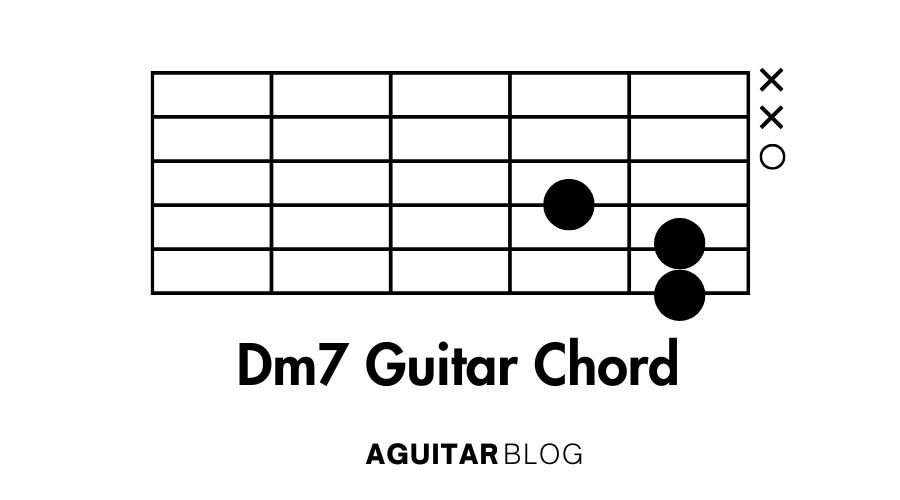The Dm7 guitar chord (D minor 7) is a widely used chord that adds a smooth, jazzy, or soulful feel to chord progressions. It builds upon the D minor chord by adding a minor seventh, creating a deeper and more complex sound. This guide will teach you how to play the Dm7 chord, its variations, and tips for practicing it effectively.
1. What is a Dm7 Guitar Chord?
The Dm7 chord is a minor seventh chord consisting of four notes:
- Root: D
- Minor third: F
- Perfect fifth: A
- Minor seventh: C
This combination gives the Dm7 chord a softer and more soulful sound than a standard D minor chord.
Dm7 Chord Formula:
- Root (D)
- Minor third (F)
- Perfect fifth (A)
- Minor seventh (C)
2. How to Play the Dm7 Guitar Chord
Here are two common voicings for the Dm7 chord on the guitar:

Open Position Dm7:
- Place your index finger on the 1st fret of the B string (2nd string).
- Place your middle finger on the 2nd fret of the G string (3rd string).
- Strum from the D string (4th string) down to the high E string (1st string), allowing the high E string to ring open.
This is the easiest Dm7 shape for beginners.
Barre Chord Dm7 (5th fret):
- Barre your index finger across all the strings on the 5th fret.
- Place your ring finger on the 7th fret of the A string (5th string).
- Place your middle finger on the 6th fret of the B string (2nd string).
- Strum all six strings for a fuller Dm7 sound.
This voicing requires a bit more finger strength due to the barre shape.
Strumming Tips:
- In the open position, avoid playing the low E and A strings to keep the chord clean.
- Make sure all the strings are ringing clearly, especially in the barre chord version.
3. Video Tutorial
For a visual guide, check out this Video Tutorial on the Dm7 Chord. Watching a video can help with finger positioning and overall technique.
4. Common Mistakes and Tips for Playing the Dm7 Guitar Chord
Common Mistakes:
- Muted strings: Make sure your fingers aren’t accidentally muting the open strings or notes that should ring out.
- Barre chord fatigue: For beginners, barre chords can be difficult. Ensure your thumb is positioned on the back of the neck for better support.
- Strumming extra strings: In the open position, avoid strumming the low E and A strings.
Tips for Playing the Dm7 Chord:
- Press down firmly: In the barre chord version, make sure you’re applying enough pressure with your index finger to avoid buzzing.
- Work on transitions: Practice transitioning between Dm7 and other chords (like G7, Cmaj7) to improve your fluidity.
- Focus on rhythm: Dm7 sounds great in both slow, melodic songs and upbeat tunes, so experiment with different strumming patterns.
5. Dm7 Chord Variations
Here are some common variations of the Dm7 chord:
- Dm7 (Barre on 10th fret):
- Move the barre chord shape to the 10th fret for another Dm7 voicing.
- Dm7 (Root on 5th string):
- Place your index finger on the 5th fret of the A string (D), ring finger on the 7th fret of the D string (A), middle finger on the 5th fret of the G string (C), and pinky on the 6th fret of the B string (F).
6. Chord Progressions and Songs Featuring the Dm7 Guitar Chord
Common Chord Progressions:
- Dm7 – G7 – Cmaj7 – Fmaj7: A classic jazz progression where Dm7 adds richness.
- Dm7 – A7 – Gm7 – C7: Used often in blues and jazz, creating a smooth flow.
- Dm7 – Am7 – G7: A simple yet effective minor progression.
Songs Featuring the Dm7 Chord:
- “Ain’t No Sunshine” by Bill Withers: Features the Dm7 chord in its iconic progression.
- “Fly Me to the Moon” by Frank Sinatra: Uses Dm7 in its classic jazz structure.
- “Landslide” by Fleetwood Mac: Includes Dm7 for a soft, emotive sound.
7. Tips for Practicing the Dm7 Guitar Chord
- Practice transitions: Move between Dm7 and other chords to make your playing smoother.
- Use a metronome: Practice with a metronome to improve your timing.
- Try fingerpicking: Dm7 sounds great when fingerpicked, especially in slower, more melodic songs.
8. Related Chords to Dm7 Guitar Chord
Here are some chords that work well with Dm7:
- Am7: Another minor seventh chord that complements Dm7 in many progressions.
- G7: A dominant seventh chord often paired with Dm7 in jazz and blues.
- Fmaj7: A major seventh chord that creates a smooth transition from Dm7 in ballads and jazz songs.
The Dm7 guitar chord is a beautiful, versatile chord that adds richness and emotion to your playing. Whether you’re playing jazz, blues, or pop, mastering the Dm7 chord will open up new musical possibilities. Enjoy experimenting with its warm, melancholic sound!
